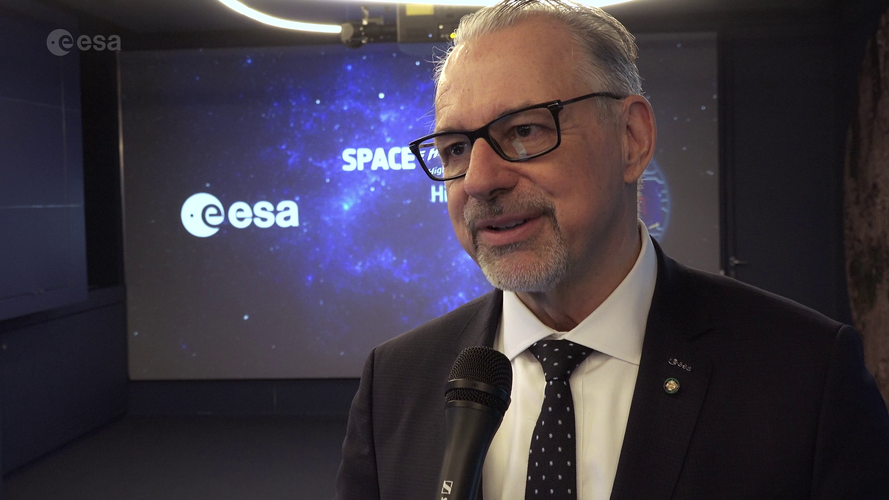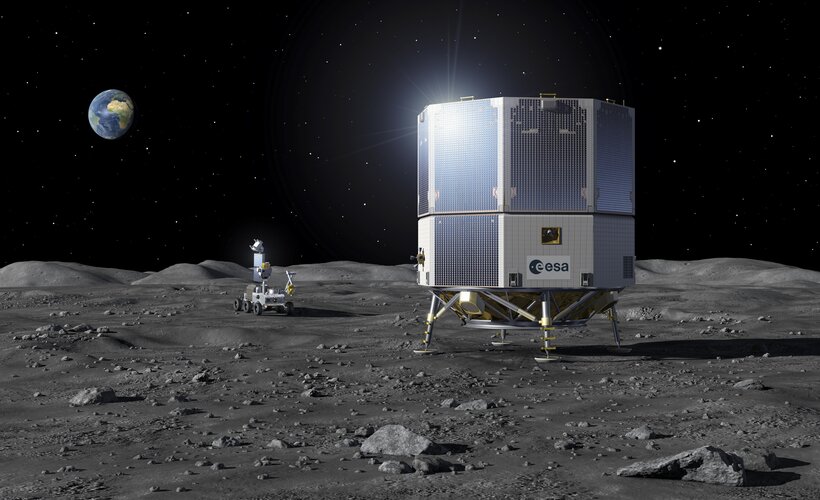
Copernical Team
Introducing the new ESA's hyper performance computing
 Video:
00:02:46
Video:
00:02:46
The high-performance computing (HPC) environment will be available for scientific research and technological development activities, supporting all ESA programmes as well as the researchers and small- and medium-enterprises from Member States.
ESA and JAXA strengthen ties on Moon and Mars exploration

The European Space Agency's (ESA) Director of Human and Robotic Exploration, Daniel Neuenschwander, and the Japan Aerospace Exploration Agency's (JAXA) Vice President for Exploration and Human Spaceflight, Mayumi Matsuura, have signed a new statement of intent focused on Moon and Mars activities. This statement marks their intention towards a step forward in space exploration cooperation between ESA and JAXA, and lays the groundwork for expanded collaboration between the two agencies in advancing science, technology and international partnerships.
Exolaunch surpasses 500 satellite deployments and debuts new Quadro system on SpaceX rideshare
 Exolaunch, a global leader in satellite deployment and mission management, has marked a significant milestone with the successful deployment of its 500th satellite. During SpaceX's Transporter-13 rideshare mission, Exolaunch deployed 27 satellites, delivering close to 1,500 kilograms of payload into orbit for clients from fourteen different countries.
This mission also marked the inaugural
Exolaunch, a global leader in satellite deployment and mission management, has marked a significant milestone with the successful deployment of its 500th satellite. During SpaceX's Transporter-13 rideshare mission, Exolaunch deployed 27 satellites, delivering close to 1,500 kilograms of payload into orbit for clients from fourteen different countries.
This mission also marked the inaugural Chinese scientists unveil six-legged robot for future asteroid and lunar mining
 A research team from China has engineered a six-legged robotic system inspired by insects, aiming to revolutionize how space mining is conducted on the moon and asteroids.
Unlike mining on Earth, extraterrestrial excavation faces unique obstacles due to low-gravity environments. The moon's gravity is about one-sixth of Earth's, and asteroids often have even weaker gravitational pull, makin
A research team from China has engineered a six-legged robotic system inspired by insects, aiming to revolutionize how space mining is conducted on the moon and asteroids.
Unlike mining on Earth, extraterrestrial excavation faces unique obstacles due to low-gravity environments. The moon's gravity is about one-sixth of Earth's, and asteroids often have even weaker gravitational pull, makin Axiom Space selects Siemens software to boost orbital infrastructure programs
 Axiom Space has partnered with Siemens to enhance the design and development of its commercial space projects by implementing tools from the Siemens Xcelerator software suite. This collaboration aims to streamline workflows and support the creation of next-generation space infrastructure, including Axiom's commercial space station and its advanced spacesuit initiatives.
"After an extensive
Axiom Space has partnered with Siemens to enhance the design and development of its commercial space projects by implementing tools from the Siemens Xcelerator software suite. This collaboration aims to streamline workflows and support the creation of next-generation space infrastructure, including Axiom's commercial space station and its advanced spacesuit initiatives.
"After an extensive Webb telescope captures its first direct images of carbon dioxide outside solar system
 The James Webb Space Telescope has captured its first direct images of carbon dioxide in a planet outside the solar system in HR 8799, a multiplanet system 130 light-years away that has long been a key target for planet formation studies.
The observations provide strong evidence that the system's four giant planets formed in much the same way as Jupiter and Saturn, by slowly building solid
The James Webb Space Telescope has captured its first direct images of carbon dioxide in a planet outside the solar system in HR 8799, a multiplanet system 130 light-years away that has long been a key target for planet formation studies.
The observations provide strong evidence that the system's four giant planets formed in much the same way as Jupiter and Saturn, by slowly building solid SuperSharp advances toward 2026 mission with funding boost and prototype completion
 SuperSharp Space Systems Ltd (SuperSharp), a spin-off from the University of Cambridge, has marked two major achievements on its path toward space deployment. The UK Space Agency has awarded the company Pounds 5 million to support an in-orbit demonstration of its innovative unfolding thermal infrared (TIR) telescope, designed to aid climate change mitigation. Simultaneously, SuperSharp has final
SuperSharp Space Systems Ltd (SuperSharp), a spin-off from the University of Cambridge, has marked two major achievements on its path toward space deployment. The UK Space Agency has awarded the company Pounds 5 million to support an in-orbit demonstration of its innovative unfolding thermal infrared (TIR) telescope, designed to aid climate change mitigation. Simultaneously, SuperSharp has final Deep learning model uncovers hidden stellar bubbles in Milky Way
 Researchers in Japan have leveraged advanced artificial intelligence to explore the distant regions of our galaxy, revealing previously undetected cosmic structures. Led by Osaka Metropolitan University, the team created a deep learning model capable of sifting through immense datasets from space telescopes, uncovering numerous bubble-like formations absent from existing astronomical records.
Researchers in Japan have leveraged advanced artificial intelligence to explore the distant regions of our galaxy, revealing previously undetected cosmic structures. Led by Osaka Metropolitan University, the team created a deep learning model capable of sifting through immense datasets from space telescopes, uncovering numerous bubble-like formations absent from existing astronomical records. 'Dark universe detective' telescope releases first data
 Europe's Euclid space telescope, which is on a mission to shed light on the mysteries of dark matter and dark energy, released its first data Wednesday with a little help from volunteers and artificial intelligence.
The telescope launched in 2023, aiming to chart one third of the sky - encompassing 1.5 billion galaxies - to create what has been billed as humanity's most accurate 3D map of
Europe's Euclid space telescope, which is on a mission to shed light on the mysteries of dark matter and dark energy, released its first data Wednesday with a little help from volunteers and artificial intelligence.
The telescope launched in 2023, aiming to chart one third of the sky - encompassing 1.5 billion galaxies - to create what has been billed as humanity's most accurate 3D map of Dark energy seems to be changing, rattling our view of universe
 Dark energy, the mysterious force thought to be driving the ever-faster expansion of the universe, appears to be changing over time, according to new observations released Wednesday.
If dark energy is in fact weakening, it would likely mean that science's understanding of how the universe works will need to be rewritten.
The new findings come from the Dark Energy Spectroscopic Instrument
Dark energy, the mysterious force thought to be driving the ever-faster expansion of the universe, appears to be changing over time, according to new observations released Wednesday.
If dark energy is in fact weakening, it would likely mean that science's understanding of how the universe works will need to be rewritten.
The new findings come from the Dark Energy Spectroscopic Instrument 
